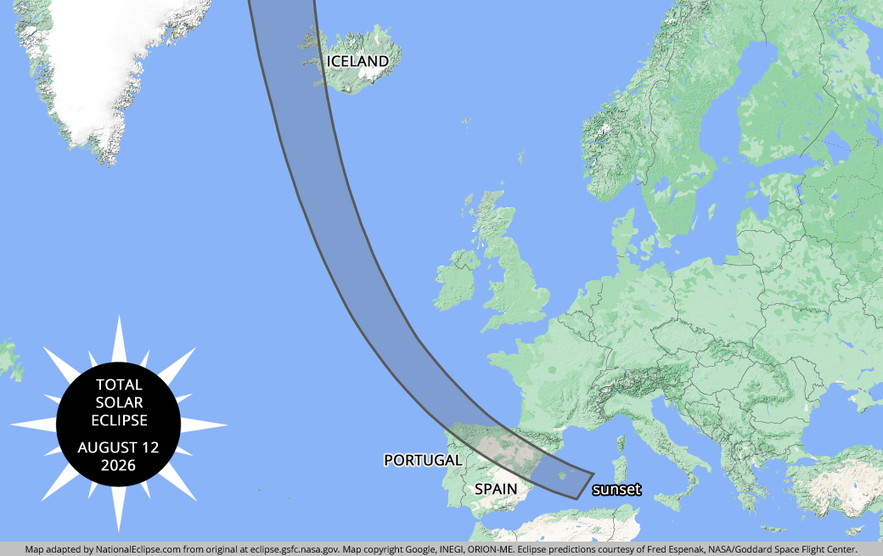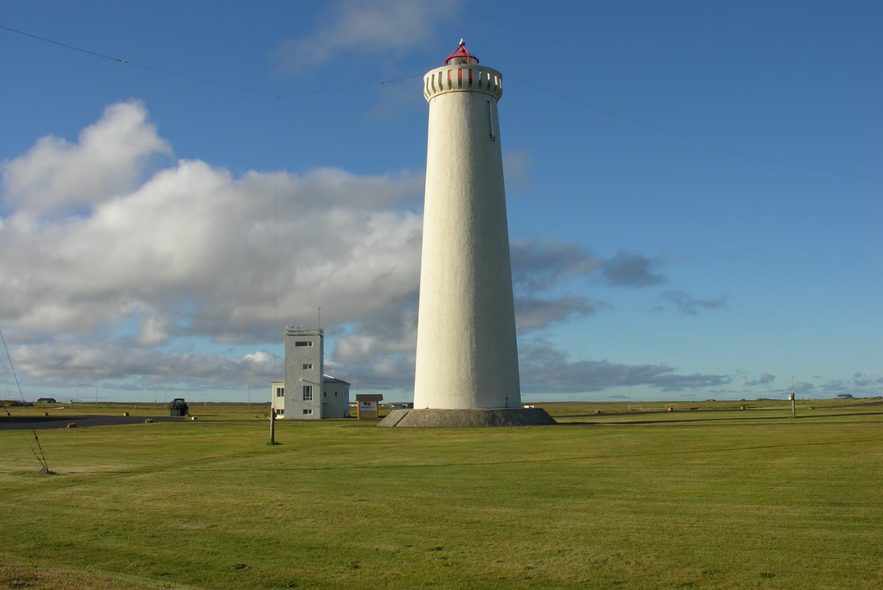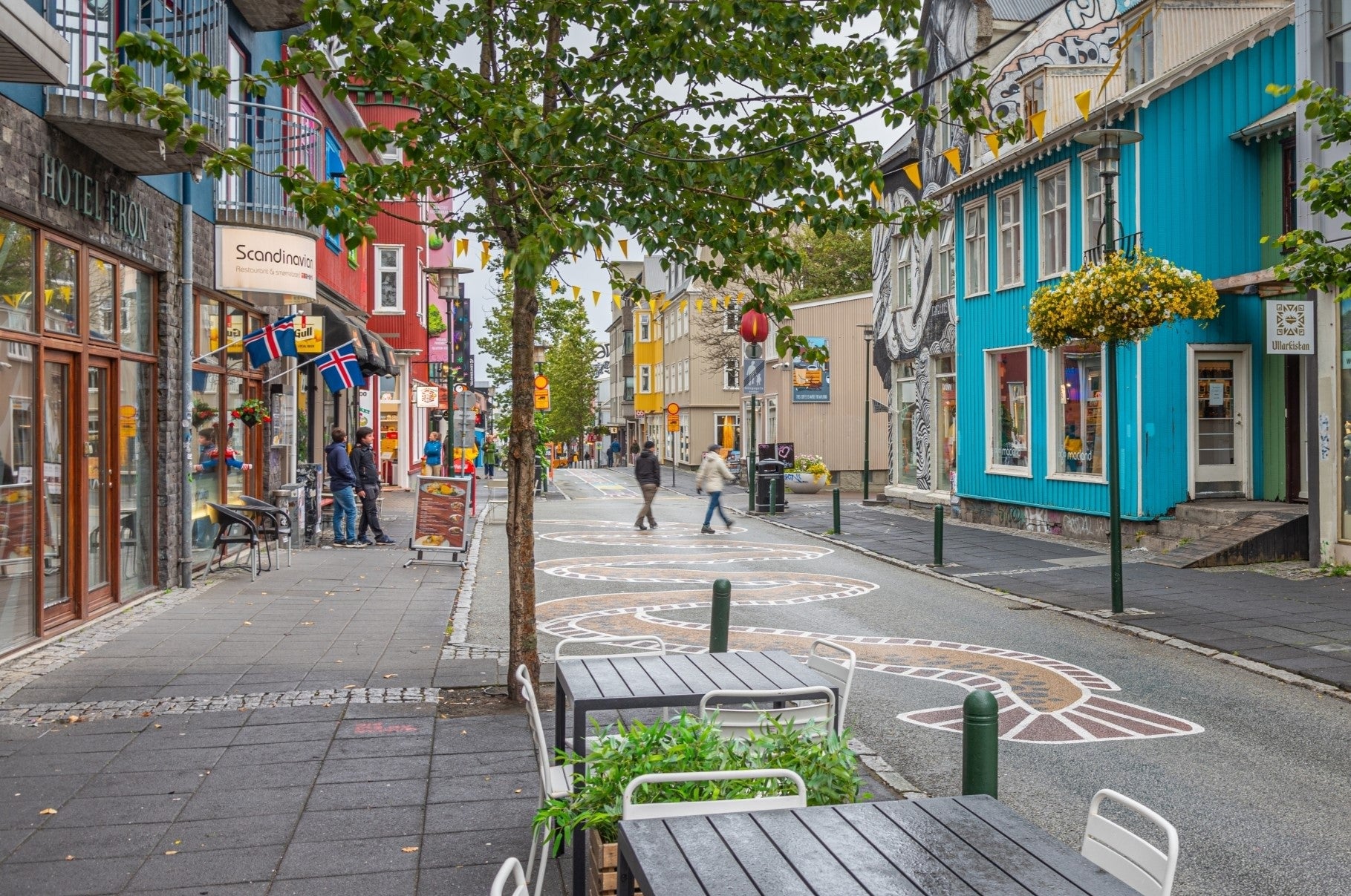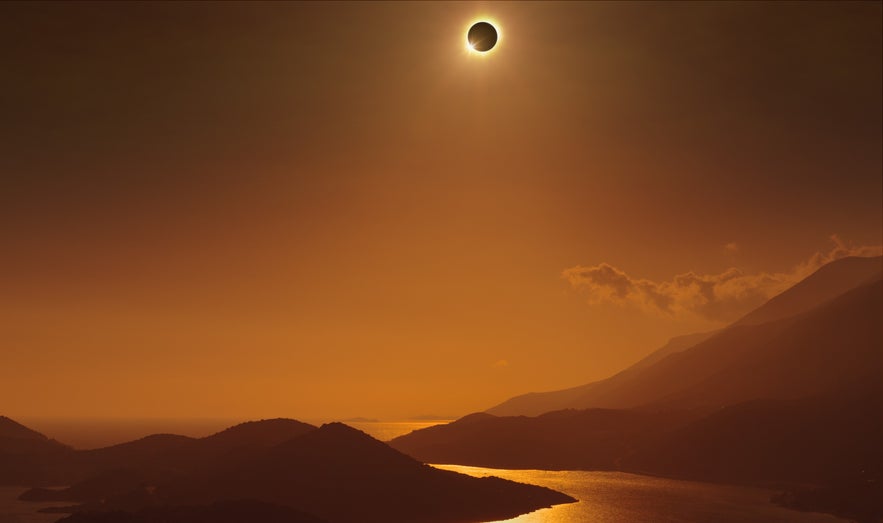
Learn about the 2026 solar eclipse in Iceland and how to witness it in one of the world’s most breathtaking landscapes. On August 12, the skies above Iceland will darken as a total solar eclipse passes over glaciers, volcanoes, and remote coastlines. Find out the best viewing spots, what to expect, and why this rare event is a must-see.
Iceland is one of the best places on Earth to see the 2026 solar eclipse. With open views, dramatic coastlines, and the longest total eclipse in Europe, it’s a great place for this special event. Many people are already planning trips to watch the eclipse over glaciers, lava fields, and wide skies. It’s a rare chance to see something truly amazing.
Why You Can Trust Our Content
Guide to Iceland is the most trusted travel platform in Iceland, helping millions of visitors each year. All our content is written and reviewed by local experts who are deeply familiar with Iceland. You can count on us for accurate, up-to-date, and trustworthy travel advice.
Booking early is recommended, as places to stay and guided tours may fill up fast. For safe viewing, ISO-certified eclipse glasses are essential and are often included with 2026 solar eclipse tours in Iceland. Browse vacation packages and accommodation options to get ready for this once-in-a-lifetime event.
Plan a full adventure across the island or choose a quiet spot to pause and gaze at the sky. Either way, this is your chance to experience something truly cosmic. The countdown begins!
Key Takeaways
-
The 2026 total solar eclipse will be visible in Iceland on August 12, 2026. It will be Iceland's first total solar eclipse in over 70 years.
-
The eclipse begins around 4:47 PM GMT, with totality (when the Sun is completely covered) peaking between 5:45 and 5:50 PM. This brings up to two minutes of darkness in West Iceland.
-
The path of totality sweeps across West Iceland, including the Westfjords, Snaefellsnes Peninsula, Reykjavik, and the Reykjanes Peninsula.
-
Iceland’s open skies, landscapes, and mild summer weather make it one of the best places to see the 2026 solar eclipse, with the longest totality duration in Europe.
What is the 2026 Solar Eclipse?
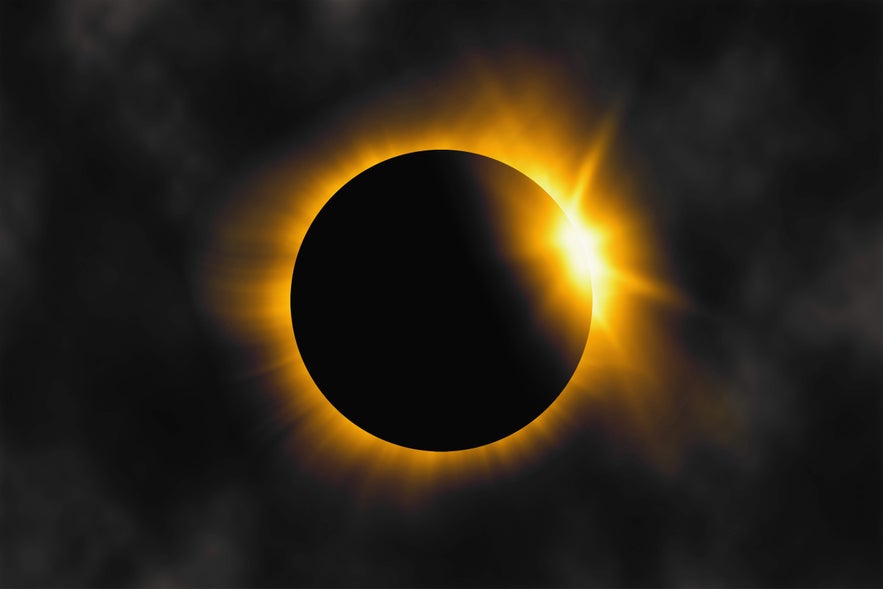
The 2026 solar eclipse will be one of the most dramatic celestial events to pass over Iceland in decades. It’s set to occur on August 12, 2026. During this event, the Moon will pass directly between the Earth and the Sun, briefly blocking sunlight and casting a shadow over parts of the planet.
Depending on the Moon’s distance and position, solar eclipses can take different forms:
-
Partial solar eclipse: When only part of the Sun is covered.
-
Annular solar eclipse: When a “ring of fire” remains visible.
-
Total solar eclipse: The rarest and most dramatic, when the Moon fully covers the Sun, turning day into night for a few fleeting minutes.
In 2026, Iceland will be one of the best places on Earth to witness the total solar eclipse. In parts of the country, the Sun will vanish completely, turning day into a dramatic twilight for a few magical minutes. Other regions will still get a stunning show, with a partial eclipse casting a mysterious glow across the sky.
Total eclipses are relatively rare in any one location because the path of totality shifts to different parts of the globe each time. That makes this upcoming eclipse such an extraordinary opportunity for skywatchers in Iceland. For those lucky enough to be in the totality track, it’s an experience you’ll never forget.
Path of the 2026 Total Solar Eclipse
Photo from National Eclipse. No edits made.
The 2026 total solar eclipse will sweep across the Northern Hemisphere, and Iceland is one of the best places to experience it. The island sits directly in the path of totality, a narrow zone where the Sun will be completely covered by the Moon.
Within this path, the closer you are to the center line, the longer the total eclipse will last. Places like Isafjordur and Snaefellsjokull are near that central path and offer some of the longest and most impressive views of this rare celestial event.
When will the 2026 solar eclipse occur in Iceland?
The 2026 solar eclipse will occur in Iceland on August 12. It will begin with a partial eclipse at approximately 4:47 PM local time, when the Moon starts to cross in front of the Sun.
Totality, the brief moment when the Sun is fully covered, will begin at approximately 5:43 PM in the Westfjords. From there, the shadow will move southeast over the Snaefellsnes Peninsula and the Reykjavik area, where totality will peak around 5:48 PM.
It will then pass over the Reykjanes Peninsula before exiting over the Atlantic just minutes later. The eclipse ends by 6:47 PM as the Moon’s shadow moves on.
Only those within the path of totality will see the Sun completely covered. Western Iceland is especially fortunate, with up to two minutes of darkness in places like the Westfjords and Snaefellsnes Peninsula. Reykjavik will experience about one minute of totality. The rest of the country will witness a deep partial eclipse, with more than 90% of the Sun obscured.
Where is the 2026 solar eclipse visible in Iceland?
The eclipse will be visible across all of Iceland, but only the western part of the country lies in the path of totality. Those outside it will still see a significant partial eclipse, with more than 90% of the Sun covered. Nonetheless, that’s an impressive sight in its own right.
Globally, this eclipse is part of a limited path that also passes over Greenland and northern Spain. This makes Iceland one of the most accessible and scenic destinations for viewing.
Best Places in Iceland to View the 2026 Solar Eclipse
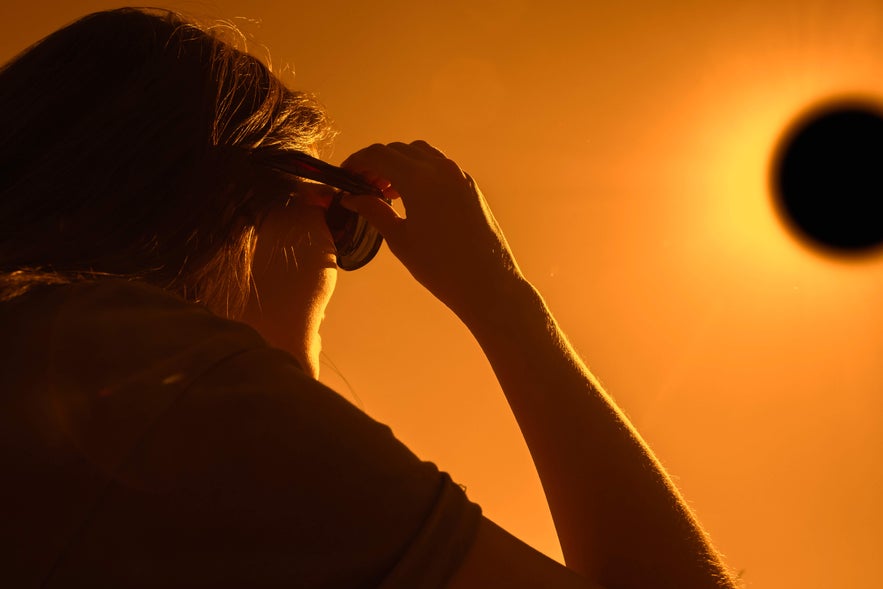
Some locations in Iceland offer a more complete view of the total eclipse than others. To experience the full effect, it's best to be within the path of totality. Here are the top regions in Iceland to catch the 2026 total solar eclipse and what to expect in each.
Westfjords (Northwest Iceland): Longest Eclipse Duration
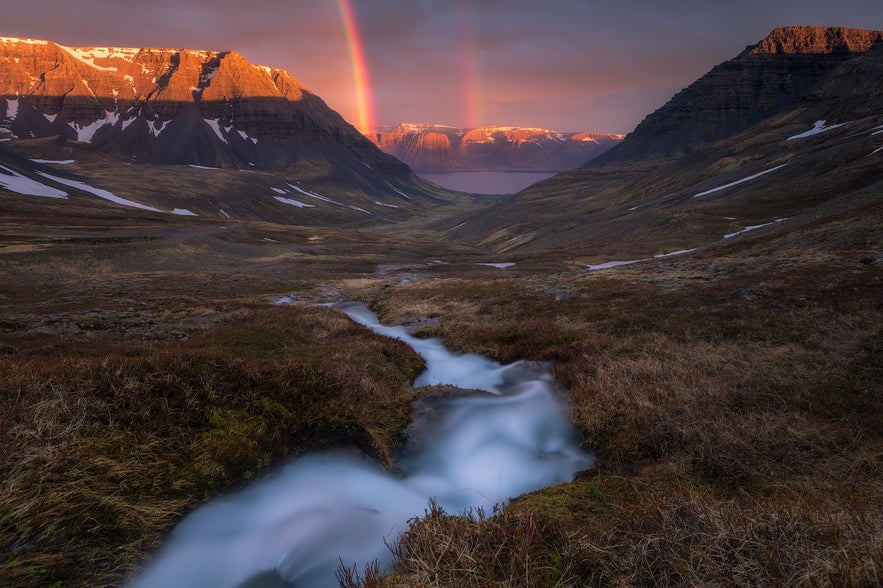
The remote Westfjords will be the first place in Iceland to see the eclipse and will have the longest time in total darkness. This area is far from busy towns, with steep cliffs, winding roads, and very few people.
One of the best places to watch the eclipse here is at the Latrabjarg Cliffs. Standing at the edge, you can look out over the wide ocean with nothing blocking your view of the sky. The wind is strong, the sea feels close, and the open horizon makes the eclipse feel even more dramatic.
Solar Eclipse Totality Highlights in the Westfjords
At Latrabjarg, a dramatic cliff on the western edge of the Westfjords, totality will last about 2 minutes and 13 seconds. This will be the longest duration on mainland Iceland, making Latrabjarg Cliffs the most ideal location for a total solar eclipse 2026 tour in Iceland.
In Isafjordur, the region’s largest town, viewers can expect around 1 minute and 30 seconds of total darkness. The Sun’s disk will be covered entirely during that time, and the pale corona will appear in the midday sky.
Scenic Viewing Spots in the Westfjords for the 2026 Eclipse
The Westfjords offer some of Iceland’s most breathtaking scenery for the 2026 total solar eclipse. The cliffs at Latrabjarg, for example, are known for their puffin colonies and provide a dramatic ocean-facing perch for watching the eclipse unfold.
On the other hand, the Bolafjall Mountain has an observation platform that overlooks the fjords. It’s a great spot to watch the Moon’s shadow move across the landscape.
For the most remote and adventurous option, Straumnes Lighthouse in Hornstrandir marks the first point where the eclipse touches Iceland. Keep in mind that reaching it involves serious planning and effort.
There are no roads or buildings, so you’ll need to take a boat and hike through quiet, open nature. It’s not the easiest spot to reach. However, for travelers who enjoy remote places and quiet nature, it can be a truly special place to watch the eclipse.
Accessibility of the Westfjords for Viewing the 2026 Eclipse
The Westfjords are one of the most remote parts of Iceland. Getting there means a long drive along curving coastal roads or a short domestic flight to Isafjordur. The journey may take time, but it’s part of the adventure. For travelers looking to escape the crowds and enjoy wide open spaces, this is one of the best places to experience the eclipse.
Accommodations in the Westfjords are limited and already filling up fast for the event. Booking early is the best way to make sure you have a comfortable base for your trip. To add to the adventure of your visit, take a look at some of the best Westfjords tours in Iceland .
Tip: Aim to arrive a day or two early to explore the area and secure a good viewing location.
Snaefellsnes Peninsula: Iconic Landscapes Under the Eclipse
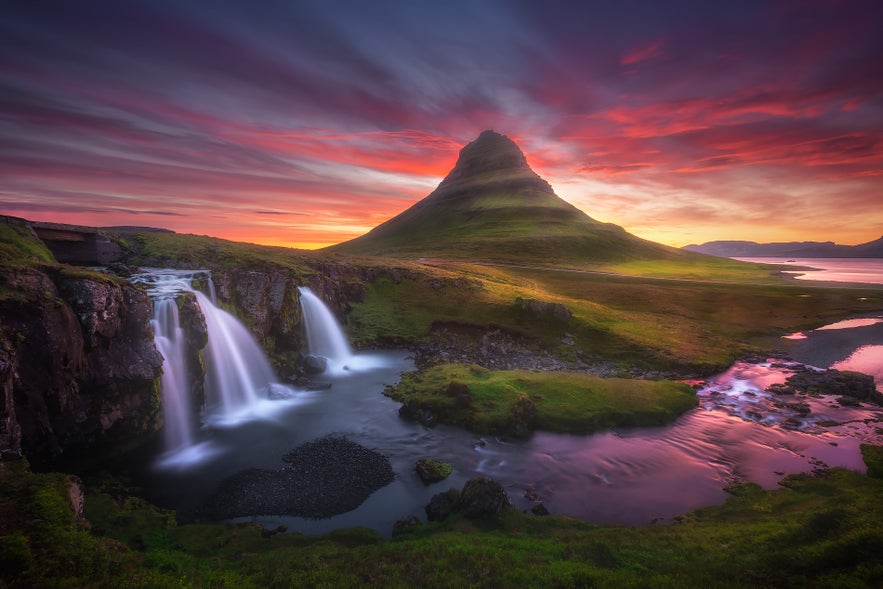
Often called “Iceland in Miniature” for its mix of volcanoes, glaciers, and coastal cliffs, the Snaefellsnes Peninsula in western Iceland lies directly in the eclipse path. Every town on Snaefellsnes will experience totality on August 12, 2026.
This region promises a totality nearly as long as the Westfjords (2 minutes and 13 seconds), plus easier access for travelers. If you want to combine scenic beauty with convenience, a guided 2026 total solar eclipse trip through Snaefellsnes Peninsula is a great option for maximizing the experience.
Solar Eclipse Totality Highlights in the Snaefellsnes Peninsula
The Moon’s shadow reaches the Snaefellsnes Peninsula around 5:45 PM, bringing up to 2 minutes and 7 seconds of totality to the northern towns of Hellissandur and Rif. This area offers some of the longest eclipse durations in the region, making it a prime viewing location.
Even popular destinations like Grundarfjordur, where the iconic Kirkjufell Mountain stands, will see about 1 minute and 50 seconds of total darkness. Across the peninsula, most locations can expect over a minute of total eclipse at its peak.
Best Viewing Spots in Snaefellsnes for the 2026 Solar Eclipse
The Snaefellsnes Peninsula delivers both an impressive eclipse duration and unforgettable scenery. Kirkjufell Mountain provides a spectacular setting, while Svodufoss Waterfall offers a more secluded yet equally stunning vantage point.
Standing at the tip of the peninsula, the Snaefellsjokull Glacier is one of the region’s most iconic landmarks and is another excellent spot for viewing the eclipse. This glacier-capped volcano was made famous by the novel, “Journey to the Center of the Earth.”
- Learn about the Top 16 Things to Do on the Snaefellsnes Peninsula
Snaefellsnes’ Accessibility for Viewing the 2026 Solar Eclipse
Snaefellsnes Peninsula is 84 miles (135 kilometers) from Reykjavik, so it’s a convenient choice for many travelers. Roads are paved, and accommodations in Snaefellsnes are easy to find. Towns like Olafsvik, Arnarstapi, and Stykkisholmur offer places to stay on or near the eclipse's centerline.
Tip: Expect some crowds at iconic spots, so arrive early on eclipse day to claim a good vantage point.
Reykjavik Area: Urban Convenience for Eclipse Viewing
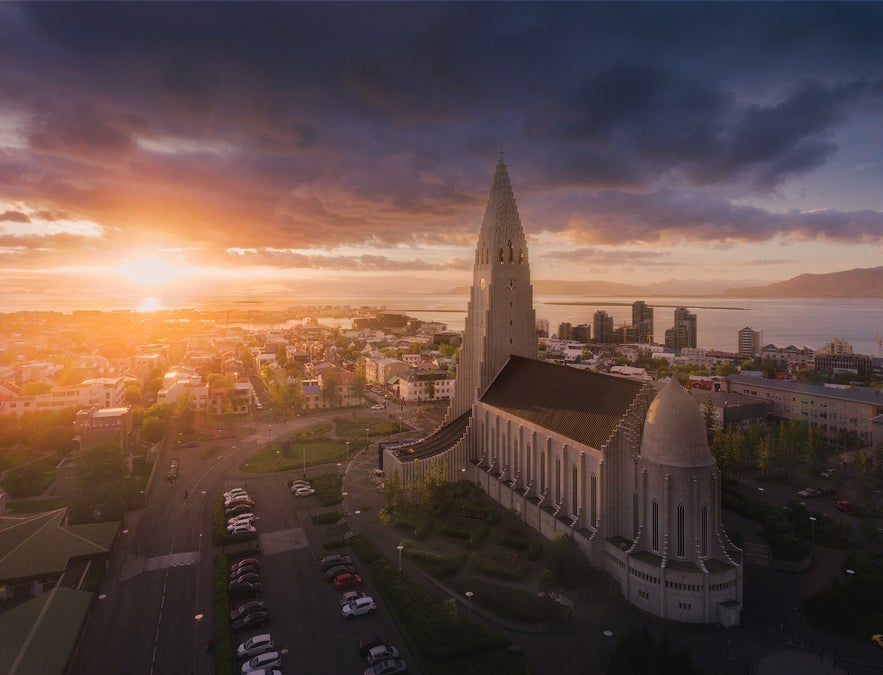
Iceland’s capital, Reykjavik, and its surrounding municipalities will also witness the total solar eclipse. However, the eclipse will happen for a shorter duration than locations farther west. The Reykjavik area is at the eastern edge of the totality path, meaning the eclipse will be only partially total there.
Solar Eclipse Totality Highlights in Reykjavik
In downtown Reykjavik, totality will last roughly 59 seconds at around 5:48 PM local time. Areas on the city’s western outskirts get a few seconds more. For instance, the totality at Grotta Nature Reserve in Seltjarnarnes lasts about 1 minute and 3 seconds. This coastal point lies just outside the city center.
Nearby towns like Akranes (north of Reykjavik) see about 1 minute and 4 seconds of totality. While shorter than in the West, a one-minute total eclipse is still an incredible experience. Daylight will suddenly give way to twilight, city lights may flicker on, and you’ll glimpse the Sun’s corona shimmering briefly above the city skyline.
Best Viewing Spots in Reykjavik for the 2026 Solar Eclipse
In Reykjavik, the key is to find a spot with an unobstructed view of the western horizon, as the sun will be low in the west during the eclipse. Good options include the Grotta Nature Reserve, Oskjuhlid Hill, or along the waterfront facing west. These spots have few obstructions, such as buildings.
Expect public gatherings, too. For example, the University of Iceland observatory or local astronomy clubs may host an event for the 2026 total solar eclipse. If you prefer a quieter spot, consider smaller towns outside Reykjavik, like Mosfellsbaer, for slightly longer totality and fewer crowds.
Best City Amenities in Reykjavik for the 2026 Solar Eclipse
The big advantage of staying in the capital is convenience. You’ll have plenty of choices for Reykjavik accommodations and easy access to restaurants and transport. Rent a car in Reykjavik and spend the day exploring the city’s museums or shops, then step out in late afternoon for the eclipse.
Just be mindful of traffic on eclipse day. Many people might drive west at the last minute, so plan where you’ll watch well ahead of time.
Tip: If you’re staying in the city, stick to a local spot rather than getting stuck on the road.
- Read about the Top 10 Hotels in Reykjavik
Reykjanes Peninsula: Accessible Coastal Vantage Points
The Reykjanes Peninsula sits at the southwestern tip of Iceland. It's home to Keflavik International Airport, the Blue Lagoon, and falls within the southern edge of the eclipse’s path of totality.
This area will experience the eclipse just a couple of minutes after Reykjavik, with surprisingly impressive durations of totality in some spots. Being relatively flat and coastal, Reykjanes offers wide-open skies for viewing and is accessible for travelers.
Solar Eclipse Totality Highlights in the Reykjanes Peninsula
Western Reykjanes will see around 59 seconds of totality. Towns like Gardur and Sandgerdi (near the peninsula's tip) will get over 1 minute 40 seconds of darkness. The Gardskagi Lighthouses in Gardur provide a particularly scenic spot to watch the eclipse, with wide views of the coast and sky.
Even at Keflavik Airport, totality lasts around 1 minute 38 seconds. This is great news for anyone flying in on the day. Of course, it’s still best to arrive before eclipse day if possible.
The absolute tip of the peninsula, at Reykjanesviti Lighthouse, will experience about 1 minute 47 seconds of totality. There, the eclipse will occur at roughly 5:50 PM local time as the shadow leaves Iceland.
Scenic Viewing Spots in Reykjanes for the 2026 Solar Eclipse
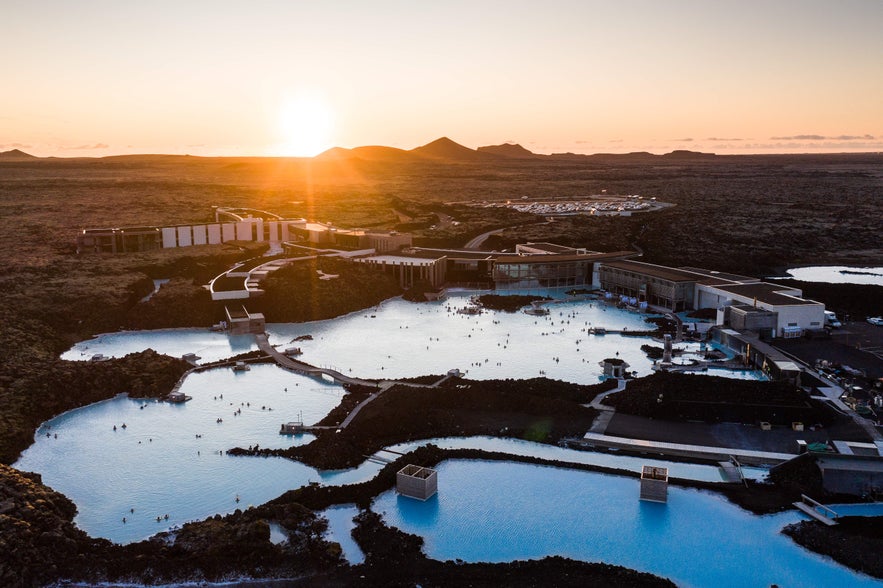
Reykjanes has a raw, volcanic beauty that creates a dramatic stage for the eclipse. Reykjanesta is a standout location where the lighthouse and cliffs face the open Atlantic. It offers wide, unobstructed views. Nearby, Gardur features a lighthouse and a clear western horizon, ideal for watching the Sun disappear.
Another unique option is getting a ticket to the Blue Lagoon geothermal spa. As totality approaches, guests soaking in the hot springs could see the daylight fade, with geothermal steam rising around them. It’s truly a surreal and atmospheric way to experience the eclipse.
Reykjanes is also a popular starting point for empowering experiences like the all-women multi-day 2026 solar eclipse tour. This activity blends skywatching with glacier hikes and hot springs for a complete Icelandic journey.
Accessibility of Reykjanes for Viewing the 2026 Solar Eclipse
Reykjanes is the easiest region to reach. It’s about 43 miles (69 kilometers) from Reykjavik, and it’s where the Keflavik International Airport is located. Thanks to good, fairly flat roads, many tour groups may choose to base themselves here for eclipse viewing. There are several stays in Keflavik and a number of hotels near Keflavik Airport, making it a convenient place to settle in before the event.
If you’re landing on August 12, you could theoretically see the eclipse right after arrival (but it’s risky to cut it that close). Plan to arrive at least a day early. Also consider pairing the eclipse with local attractions like the Bridge Between Continents or Gunnuhver Hot Spring, which are in this area.
- Also, check out the Best Hotels Near Keflavik Airport
Tip: No matter which “best place” you choose, make sure to get there with plenty of time to spare on eclipse day. Local traffic to these areas will likely increase, and you want to be safely at your viewing site at least an hour before the eclipse starts.
Why Iceland Is an Ideal Destination to Witness the Eclipse
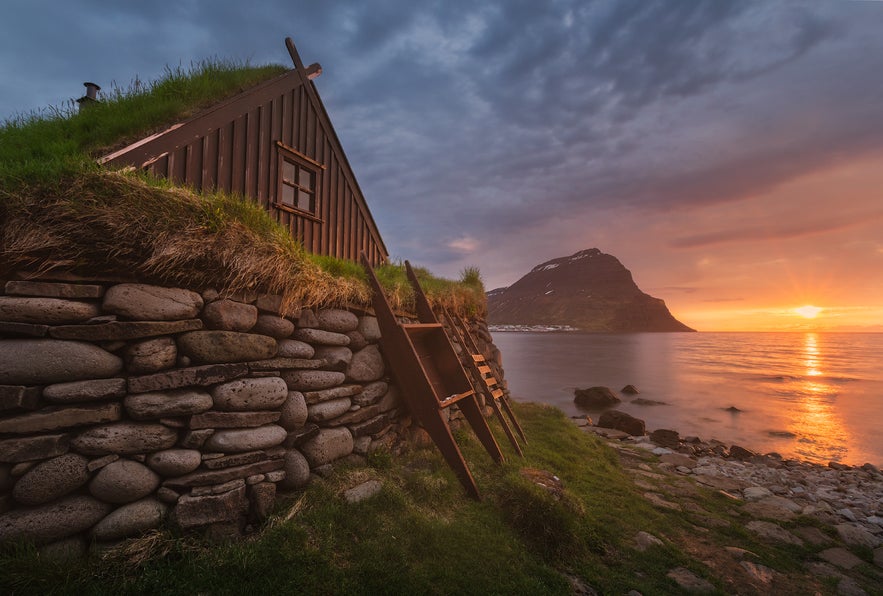
Iceland presents one of the most complete experiences for watching a total solar eclipse. The combination of extended totality, stunning natural scenery, and accessible viewing locations creates the perfect setting for the moment’s rare magic.
Iceland Has the Longest Total Eclipse in Europe
Among all the land-based destinations in the eclipse’s path, Iceland offers the longest duration of totality in Europe. The western part of the country will experience up to two full minutes of darkness, giving eclipse watchers a slightly longer window than other locations.
While a few extra seconds may not sound like much, they matter when you're standing under a sky that’s suddenly gone silent and dark. It’s a rare moment, and Iceland’s position near the centerline ensures viewers get to stretch that moment as much as nature allows.
Iceland’s Landscape is Made for a Total Eclipse
There’s something otherworldly about watching the sky go dark above a landscape shaped by fire and ice. In Iceland, you might be standing on a black sand beach, beside a moss-covered lava field, or near the base of a glacier-capped volcano when the Sun disappears.
The country's natural backdrop of glaciers, waterfalls, fjords, and volcanic peaks amplifies the surreal feeling of totality. Here, the eclipse goes beyond the sky and becomes something you feel. Photographers will especially appreciate the unique lighting and striking contrasts that unfold in those few minutes.
Iceland Offers Easy Access to the Path of Totality
Unlike many eclipse paths that cross oceans or isolated terrain, Iceland’s path of totality covers areas that are relatively easy to reach. Regions like the Westfjords, Snaefellsnes Peninsula, and the greater Reykjavik area are accessible by road, and infrastructure is well-developed by Icelandic standards.
You can arrive by air through Keflavik International Airport or take the scenic drive along the Ring Road. Either way, reaching a great eclipse viewing spot is surprisingly straightforward. For those craving more remote landscapes, Iceland still offers plenty of wild terrain to explore.
Iceland Weather in August Can Be Mild but Unpredictable
The weather in Iceland is constantly changing, and August is no different. It's considered one of the milder months, with relatively warmer temperatures and longer daylight hours than the rest of the year.
Average temperatures usually range from 57 F to 59 F (14 C to 15 C), making it cool but generally comfortable. Still, conditions can shift quickly. Wind, cloud cover, and rain are all possible, even during summer.
The eclipse will occur in the late afternoon, when the light often has a soft golden tone. If the skies are clear, the sudden drop in sunlight will be dramatic and unforgettable. Even under partial cloud cover, the moment can still feel powerful. As with any trip to Iceland, it’s best to be ready for all types of weather.
- Read more about The Ultimate Guide to Iceland in August
Iceland Provides a Full Travel Experience
The eclipse is just one reason to visit Iceland in August. Many travelers will most likely pair the event with tours along the Golden Circle, visits to geothermal spas like the Blue Lagoon, or adventures in the western region exploring cliffs, puffin colonies, and hot springs.
Stay a few extra days and you might even catch the northern lights, which sometimes begin to appear by late August (no promises though!). Few destinations let you combine a total eclipse with a road trip past waterfalls, volcanoes, and glacial lagoons.
As the eclipse draws closer, Iceland will become a hub for astronomers, photographers, and travelers chasing the phenomenon. Many will gather in popular regions like Reykjavik and Snaefellsnes Peninsula to share the moment.
Standing in silence with a group of strangers as the sky goes dark, and then erupts in cheers when the Sun reappears, is something people will talk about for the rest of their lives. Iceland invites that sense of connection, not just with the cosmos but fellow travelers who will come for the same extraordinary moment.
Past Solar Eclipses in Iceland
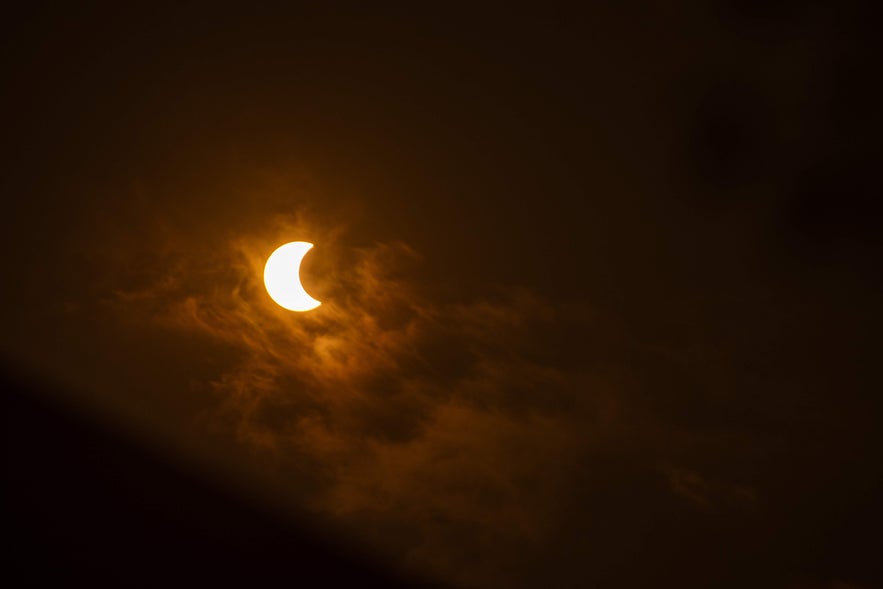
This isn't Iceland's first time witnessing such a spectacle, but it's been a long wait. The last total solar eclipse visible from Iceland occurred in 1954, and opportunities like this are extremely rare here.
While partial eclipses occur more frequently, total eclipses only pass over the same region once every few decades, or longer. That makes August 12, 2026, not just a major astronomical event, but a historic moment for Iceland!
Travel Tips for 2026 Solar Eclipse in Iceland
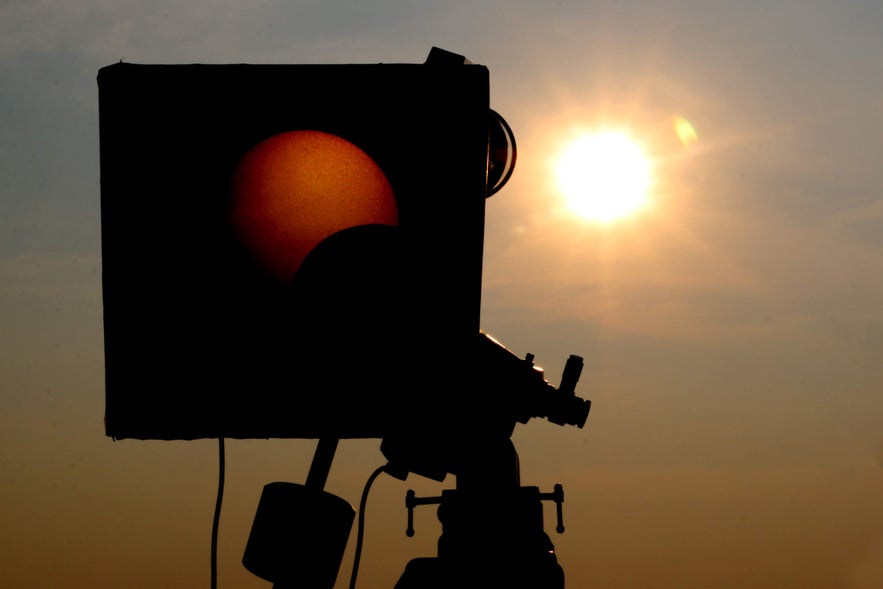
Viewing a total solar eclipse is exciting but requires some preparation to ensure a safe and enjoyable experience. Here are essential tips for travelers and enthusiasts planning to witness the 2026 Iceland eclipse:
Eye Safety First
Never look at the Sun without proper protection except during the brief totality. Bring certified solar eclipse eyewear (ISO-certified eclipse glasses or viewers) and put them on during all partial phases.
Regular sunglasses don’t provide sufficient protection.
Also, make sure to get solar filters for cameras or binoculars if you’ll use them. Looking through a lens will intensify sunlight and damage your eyes or equipment without proper filters.
Plan for Weather
Iceland’s weather can be unpredictable even in summer. Check the forecast for your chosen viewing area on eclipse day. If there’s a risk of clouds, have a backup location.
Keep an eye on the Icelandic Meteorological Office updates as the date nears. Even if it’s cloudy, remember that it will still get dark. You’ll notice the eclipse’s effect even if the Sun itself is hidden. But, of course, clear skies are ideal to see the Sun’s corona.
Arrive Early
Expect a surge of travelers and locals heading to prime eclipse spots on August 12, 2026. Reach your viewing location early, ideally a few hours before the eclipse begins or even the day before for remote spots.
This ensures you have parking, a good viewing angle, and time to set up any equipment. Plus, the partial phases start an hour before totality, so you’ll want to be ready to observe those with your glasses on.
Bring All Essential Gear
In addition to eclipse glasses, bring any gear you might need for comfort and viewing:
-
Warm Clothing and Rain Gear: Dress in layers. Even in August, it can be cool or windy, especially if you’re near the coast or on a hill. Have a waterproof jacket in case of light rain or drizzle.
-
Tripod and Camera (optional): Use a tripod for steady eclipse photos or videos. If you plan to photograph the Sun directly, make sure your camera is equipped with a proper solar filter. It’s also ideal to practice your eclipse shots beforehand.
-
Flashlight or Headlamp: It will be daytime, but during the 1 to 2 minutes of totality, it will get dark enough that a small light might help if you need to check settings or find something in your bag.
-
Snacks and Water: If you’ll be staking out a spot for hours, especially in remote areas, have food, water, and a thermos of something warm. There may not be open restaurants or stores in the wilderness of the Westfjords or on a mountain pass.
Book Travel Very Early
Treat this once-in-a-lifetime event like a festival. Accommodations and flights for the week of the eclipse will book up fast. Reserve hotels and rental cars well in advance, think a year or more ahead if possible.
Focus on lodging in or near the totality path. Also, consider booking a guided 2026 solar eclipse tour if you prefer a structured trip. These packages often include transportation to a viewing site, experts on hand, and sightseeing around the eclipse.
Scout Your Spot
If possible, visit your chosen viewing location ahead of time, either earlier in the week or on the day of the eclipse. Try to figure out where the Sun will be in the sky, which is usually in the west or southwest in the late afternoon.
Make sure nothing will block your view during the eclipse. Avoid areas near mountains or tall buildings that could hide the Sun. A simple compass can help you find the right direction.
However, for a more detailed plan, try the Eclipse Guide 2025–2027 Times app. Available for Android and iOS, it shows eclipse visibility, timing, and sky simulations based on your location. The app has a small fee, but it’s a great tool for getting the most out of the experience.
FAQs About the Solar Eclipse in 2026
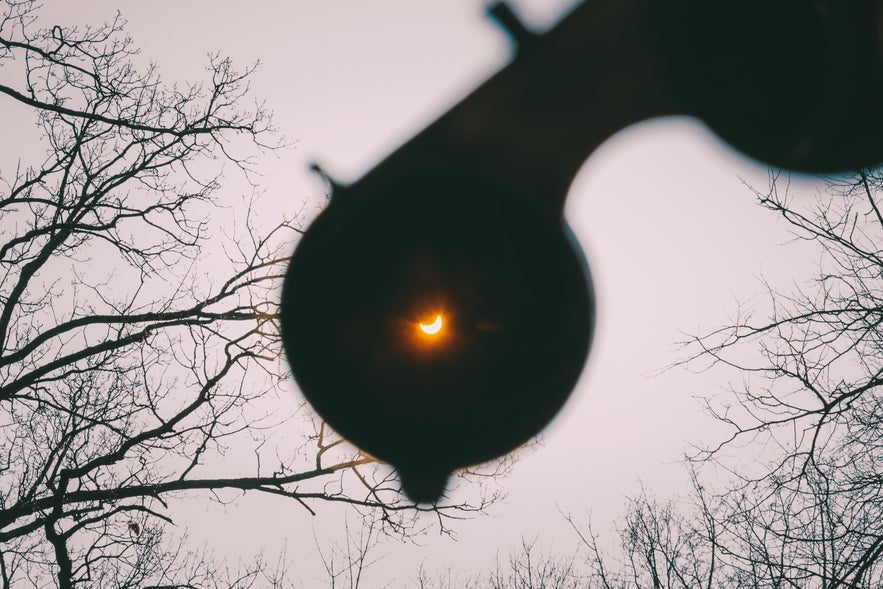
Here are some of the most frequently asked questions about the solar eclipse in Iceland.
What is the 2026 total solar eclipse time in Iceland?
The 2026 total solar eclipse in Iceland will begin around 4:47 PM local time on August 12, 2026. Totality (when the Sun is completely covered) will occur between 5:43 PM and 5:50 PM, depending on your location.
In Reykjavik, totality is expected at about 5:48 PM, lasting roughly one minute. Meanwhile, western areas like the Westfjords and Snaefellsnes Peninsula will experience over two minutes of total darkness.
The eclipse ends around 6:47 PM, making the entire event (partial to total to partial again) last about two hours. Since the eclipse occurs in the late afternoon, viewers will experience a striking contrast as the sky darkens during what’s usually broad daylight in August.
Where is the best place to see 2026 solar eclipse in Iceland?
The best places to see the 2026 solar eclipse in Iceland are within the path of totality, particularly in West Iceland. Top spots include the Westfjords, Snaefellsnes Peninsula, and parts of the Reykjanes Peninsula and Reykjavik area. These regions will see totality, while the rest of the country gets only a partial eclipse.
Locations like Latrabjarg Cliffs, Bolafjall Mountain, and Grotta Nature Reserve near Reykjavik are excellent for both clear views of the sky and dramatic scenery. The closer you are to the center of the path, the longer the totality lasts, so it’s worth planning to be in West Iceland for the most complete view.
Are there guided tours available for viewing the Solar Eclipse 2026?
Yes, there will be guided eclipse tours in Iceland for August 2026, especially in areas along the path of totality. These tours often include transportation, expert guides, safe viewing equipment like eclipse glasses, and stops at scenic or culturally significant sites before or after the eclipse.
Many travelers choose guided options to avoid navigating weather, crowds, and logistics on their own. Booking early is recommended, especially for popular areas like Snaefellsnes Peninsula or the Westfjords, which are expected to draw eclipse watchers worldwide.
Experience the 2026 Solar Eclipse in Iceland
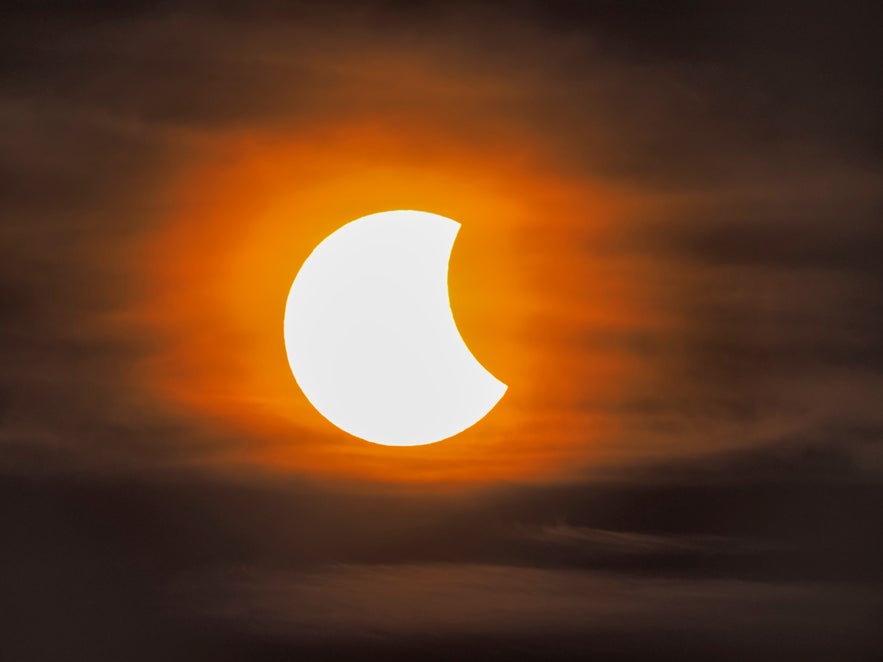
The 2026 solar eclipse in Iceland will be more than a skywatching event. It’s a moment where nature, science, and breathtaking natural settings all align. For those lucky enough to stand in the Moon’s shadow, it will be a memory that lingers long after the light returns.
Plan ahead, pick your spot, put on your eclipse glasses, and be ready to look up. You might come for the adventure, the scenery, or the spectacle, but one thing’s for sure: Iceland is where the eclipse will leave its biggest impression!
Will you be in Iceland for the 2026 solar eclipse? Have you already picked your viewing spot, or are you still deciding where to go? We’d love to hear your plans (or even your past eclipse stories) in the comments below!

